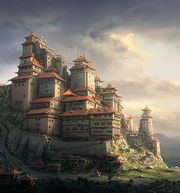The Yoshimo Shogunate
| The Yoshimo Shogunate Tsukihon
|
||||||
|---|---|---|---|---|---|---|
|
||||||
| Capital | DaiToshi | |||||
| Largest | Hansokyo | |||||
| Official languages | Tsukihonese | |||||
| Ethnic groups | Tsuki 98%, Other 2% | |||||
| Demonym | Tsukihonese | |||||
| Government | Militaristic Dictatorship | |||||
| - | Shogun | Shimada Yoshimo | ||||
| Population | ||||||
| - | 2015 census | 108.4 Million | ||||
| GDP (nominal) | estimate | |||||
| - | Total | 2.6 Trillion | ||||
| Gini (2017) | 40 medium |
|||||
| HDI | very high |
|||||
| Currency | Tsukihonese Yen (TKY) |
|||||
| Drives on the | right | |||||
| Internet TLD | .tks .mtk .sgov | |||||
The Yoshimo Shogunate is the current government representing the Tsukihon nation. It is an ancient nation with the history of strive against foreign influence and the fierce protection of traditional values. Since antiquity, the Tsuhon people have lived on their island, over time influencing the surrounding Islands trying to stay out of the world’s affairs for the sake of inner-development and not wanting to squabble with what is seen as, ‘the lower world’. While your typical Tsukihonese may have a superiority complex, the people generally are welcoming to outsiders, despite the commoner bias. Of great tradition and history, internally and against invaders, Tsukihon has stood the test of time and is determined to do so, from war to economic domination by fiercely efficient and pragmatic means.
Contents
Government and Politics
Current Shogun
Shimada, of the Yoshimo family, came into power after the passing of Shintani Uesegi. This ushered in a new era, as the Yoshimo royal clan took over the Shogunate after a brief coup to secure the Dai-Gekko throne from other competing factions. Shimada Yoshimo effectively united Tsukihon, after abolishing much of the feudal power the Daimyo's held in favor of a governing system more central to the Shogunate. The new Edicts of from the Dai-Gekko Throne stated that Daimyo's may keep and establish control over their economic entities but cannot maintain political feudal power. Through military backing, these edicts were enforced, solidifying the Yoshimo family as the only Clan capable of ever succeeding the Shogunate, Dai-Gekko Throne. Since then, Shogun Shimada has introduced an array of reforms, mostly economic, to boost the quality of life and strength of the Tsukihonese people.
Responsibilities of the Shogunate
The Shogunate, is the name of the administration working under the Shogun, and is effectively the dominant political force in the country. The Shogun, heads the administration as the hereditary dictator of Tsukihon. This power, is usually kept in check and solidified by the existence of the Omo-Senshi, a class of Lord-Warriors who are considered the high upper class of the economic and political landscape. Without the Omo-Senshi's backing, the Shogun has no legitimacy. Individually, the Omo-Senshi are commonly referred to as Bushi, and less commonly, as Samurai. The Omo-Senshi are effectively put in control of several matters, ranging from economic duties to mainly, militaristic advise. Also within the Shogunate, is the cabinet, which are the assigned Lord Shugoden, who manage various aspects of the country, typically, they are also Bushi, though in modern any Tsukihonese, can make it to such a position.
Omo-Senshi Politics
Though not common, the people aren't discouraged from pushing petitions, though it is up to the Shogun and Omo-Senshi to reject or approve of proposed reforms. Mainly however, there are differing political factions of Bushi within the Omo-Senshi community, These are mainly in part, due to the way the Bushi interpret their Bushido Code differently. There are two primary factions in Tsukihon that rule on a theological and political basis.
These are the [b]Kurai[/b] and [b]Koji[/b] Bushi. Both within the Omo-Senshi temples are feared and respected, as most lend their ideals to either one. The Kurai, typically believing in expressing an array of abilities, mostly physical, through raw power and anger. The Kurai are also known for being in the moment pragmatic, almost calculating in a self-benefiting manner to maintain superiority. The Koji are the light side, more idealist and widely referred to as 'moving like water' as an ideology to life in general/ All Tsukihonese are pragmatic, however the Koji use the Bushido Code as more of a moral compass, rather than an almanac for power and physicality. In a sense, the Koji interpret the Bushido code philosophically, while the Kurai, more literally.
Species and Culture
The Tsuki
The Tsuki, meaning 'moon' and 'elven of the moon', are otherwise known as 'Elves' or Erubusu in native Tsukihonese. They are similar to humans in body structure, however are more slender. This comes naturally with the Tsuki's unusually high metabolism. The Tsuki are also taller, than your average human, with the average height of a Tsuki leveling out at 6'5 ft. Skin complextion can range from dark grey to a more pale grey, though darker is much more common, some Tsuki may even have a purple or blue hue to their skin. Color of skin is dictated regionally on the homeland island. Eyes, range from green, red or yellow, unless a Tsuki happens to have human lineage in his or her history, in which case they are seen as lower. Lower eye color is typically blue, or brown and non- luminesent. Tsuki eyes tend to glow with the appearance of luminescence. The compounds of their eyes gives them complete nightvision, but due to the nature of their always overcast, and damp homeland, Tsuki eyes are sensitive to sunlight, this sensitivity in part explains their nocturnal ways. Tsuki ears are pointed and long, usually a defining feature alogn with their unique eyes and skin color, as well as height.
Tsuki, are generally very pragmatic, serious, monotone and reserved. While natural engineers, their traditionalism has led them to modernize late, yet catch up significantly with the world due to their uncanny ability to learn quickly. Tsuki, have a hard time understanding other races, such as humans mostly. Tell a Tsuki a joke, and they will take it quite literally. That said, Tsuki are not lacking in the arts. However, these arts are mainly driven by the Bushi Warrior culture. One that is eloquent, and strives to teach perfection through the strict practice of the Bushido Code through daily life. This theory if Collective Pragmatic Bushido, has led to a highly coordinated, modern Tsuki society.
The Omo-Senshi
The Omo-Senshi, otherwise known as Bushi, are the dominant caste of Tsukihonese society. Their roots can be traced back to being Heroes of the island, defenders and servents of the Lord Daimyo's across feudal Tsukihon. Today, the Bushi are still warriors, but play a broader role in running and controlling the country. They are known by modern standards as the 'High Upper Class'. Bushi serve in anything from the military, as officers, to Governors or businessmen, all functioning off the ethnics of the Bushido code. This has allowed the military institution to spread far and wide, encompassing many roles and contributions to Tsukihon society. In all, there are eight values of Tsuki Bushido:
Righteousness (義 gi), Courage (勇 yū), Benevolence (仁 jin), Respect (礼 rei), Sincerity (誠 makoto), Honour (名誉 meiyo), Loyalty (忠義 chūgi), Self-Control (自制 jisei)
The Bushido Code, is the law of the land. There are many laws that derive from each virtue, all enforced by the Shogunate.





